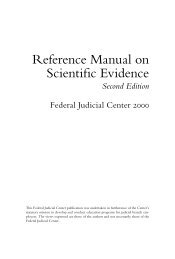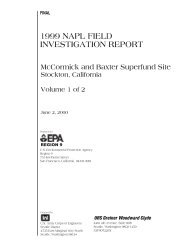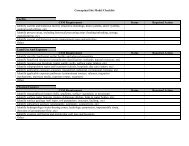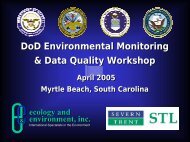Source Zone Delineation Demonstration Report - Triad Resource ...
Source Zone Delineation Demonstration Report - Triad Resource ...
Source Zone Delineation Demonstration Report - Triad Resource ...
Create successful ePaper yourself
Turn your PDF publications into a flip-book with our unique Google optimized e-Paper software.
A comparison between the predicted and the measured TCE concentration profile in the vapor phase wasconducted using the three-dimensional distribution of TCE in the subsurface at OU 12 developed usingthe EVS-Pro software system (CTECH, 2002) and based on the data collected during the Wireline CPTsoil sampling investigation. Since the EVS modeling domain used to develop the distribution of TCE insoil is different than the VENT3D modeling domain, an orthogonal (x,y) grid was created in EVS thatwas coincident with the grid in VENT3D. Once the orthogonal grid was created, two EVS models werebuilt. The first model consisted of 14 layers with each layer five feet thick and was identical to theVENT3D grid. The ASCII output from EVS was then reformatted for use in VENT3D. The averagevalue was used for each layer because the original EVS model was based on vertical layers of two feet inthickness and not five feet as was used in the VENT3D model for the soil vapor simulations. Using avertical grid spacing of five feet in EVS rather than two feet results in additional vertical averaging.Thus, the maximum TCE concentration in VENT3D (38.9 mg/kg) is much lower than the maximum TCEconcentration in the original EVS soil model (100 mg/kg).To address the issue of vertical averaging, a second EVS soil model was created and consisted of 70layers with each layer one foot thick. To generate the TCE concentration at each node (x,y,z) of theVENT3D model, the output from the 70 layer EVS model was segregated into 14 layer-groups of fivelayers each with each group spanning five feet The maximum TCE concentration at the specified x and ycoordinate within each group for each layer was used as the TCE concentration for each VENT3D node.For example, for layer 2 in VENT3D, the maximum at each x and y coordinate was selected from EVSlayer-group 2, which consisted of EVS layers six through ten. Thus, the maximum TCE concentration inVENT3D is consistent with the original EVS model.The EVS transformed TCE source configuration is referred to as source area 10 for the VENT3Dsimulations. The distribution of TCE in the soil for the bottom 12 layers (i.e., 10 to 70 feet bgs) of theEVS average layer model and the EVS maximum layer model is shown in Figures 5-50 and 5-51,respectively. As is apparent from the figures, the vertical averaging required to transform the 2-footlayers from EVS into 5-foot layers for use in VENT3D resulted in lower overall TCE soil concentrationsas well as a smaller distribution of TCE within the modeling domain as that generated with the EVSmaximum layer model transformation.A comparison between the predicted and the measured TCE concentration profiles in the vapor phase atall seven extraction wells for source area 10 is shown in Figures 5-52 and 5-53. The main difference inthe predicted TCE vapor concentrations between the EVS average layer model (Figure 5-52) and the EVSmaximum layer model (Figure 5-53) occurs for extraction wells U12-VP1, U12-VP2, and U12-VP4. Thepredicted vapor concentrations at these particular extraction wells are significantly higher for the EVSmaximum layer model due to the higher soil concentrations and the close proximity of these wells to thesuspected source. However, most notable is that for both concentration scenarios (EVS average layer andEVS maximum layer), the predicted response is significantly different than the actual measured responseat all seven extraction wells.March 2003 5-79 OU 12 <strong>Demonstration</strong> <strong>Report</strong>Final










